Apple I Replica Creation -- Chapter 1: Apple I History
| Chapter 1 |
| Apple I History |
Introduction
Steve Wozniak's microcomputer, the Apple I, served to launch the Apple Computer Company and generated an outburst of innovation that revolutionized the way people use computers. This book won't tell you who provided the venture capital or what date Apple was incorporated. Instead, this book is about computers, how to build them, and how to program them. In this first chapter, we will examine the history of the Apple I computer itself, its peripherals, modifications, and the community of users who were the first in the world to own a personal computer.
Merely finding an Apple I to buy was a daunting task in 1976. Two hundred were made. The Byte Shop purchased 100 of these. Most of the remainder was sold at other stores and through an ad in Interface Age. The retail price of $666.66 wasn't much, but all that bought you was the circuit board (Figure 1.1). It was up to the user to find a keyboard, power supply, and video monitor.

Figure 1.1 Apple I Circuit Board
With a user base of fewer than 200, nobody was making peripherals specifically for the Apple I. The power supply could be built with standard parts. For an ASCII keyboard, a Datanetics Corporation keyboard was the most common choice (Figure 1.2). The user had to make the cable on his own. A video monitor could be used for the display, but it was cheapest to buy an RF modulator and connect the computer to a television. The Apple I was the first computer of its kind to use a keyboard and monitor as standard input/output devices. Most competing systems, such as the Altair, used rows of lights and switches to communicate with the user or provided a serial port for use with an expensive Teletype unit.
Programs were loaded onto the Apple I either by typing the machine code in by hand or by transferring the program from an audio cassette. Apple BASIC was only available on cassette and most users were not keen on loading their programs by hand; therefore, the Apple I's cassette interface (Figure 1.3) was a ubiquitous option. Apple sold a handful of games on cassette, but nobody bought a microcomputer in 1976 to run commercial software.

Figure 1.2 Apple I with Datanetics Keyboard
The concept of commercial software barely existed in 1976. Companies like Apple made their money from hardware sales. Nine programs were available on cassette: BASIC, Mastermind, Lunar Lander, Blackjack, Hamurabi, Mini-Startrek, 16K-Startrek, Dis-Assembler, and Extended Monitor. Apple sold these at just $5 each to encourage interest in the Apple I. Hobbyists wrote their own software and shared it freely with one another, eager for the opportunity to show off their innovations and share what they learned. Equal liberty was taken with manufacturers' software. Micro-Soft (as it was known before changing its name to Microsoft), which wrote BASIC for the Altair, was the first company to have a financial interest in software sales. "I would appreciate letters from anyone who wants to pay up," Gates wrote in his poorly-received "Open Letter to Hobbyists."

Figure 1.3 Apple I Cassette Interface
With the exception of those nine programs sold on cassette by Apple, any software the Apple I user wanted to buy or copy out of a book had to be laboriously translated by hand from its original format into Apple I BASIC or Assembly. A similar situation existed for the hardware. There were few microcomputer peripherals to which the competent engineer couldn't interface, but none of these was actually intended for the Apple I.
One popular device was the Southwest Technical Products Corporation (SWTPC) PR-40 alphanumeric printer (Figure 1.4). This printer cost $250 and, like the Apple I, did not support lower-case characters. It used standard adding machine paper and could print 40 characters per line. The Apple I had no parallel port, but users could build a small circuit that would redirect video output to the printer.

Figure 1.4 SWTPC PR-40 Printer
Another peripheral, called the KIMSI (Figure 1.5), was an interface that allowed popular S-100 peripherals to be used with the MOS KIM-1 computer. With only minor adaptations, the KIMSI could be attached to the Apple I's 44-pin expansion bus. Any S-100 card could be used with this interface, but writing programs that used the cards was up to the Apple I user.

Figure 1.5 KIMSI Interface
The most ambitious upgrade to the Apple I was the addition of a SWTPC GT-6144 Graphics Board (Figure 1.6). The graphics board allowed the system to display a 64-by-96 array of rectangles (pixels) in black and white. It was available only as a kit and, like the PR-40 printer, it interfaced to the computer via a parallel port. After building a simple custom interface to attach the graphics board, the user could write programs that drew graphics to the screen or even performed simple animations.

Figure 1.6 GT-6144 Terminal System
Apple I Owners Club
In the earliest days of the Apple I, Steve Wozniak would visit the Homebrew Computer Club, sharing schematics and giving away code. Fellow hobbyists could even expect hands-on support from Woz as they experimented with their early Apple I computers. As Apple grew, the new Apple II quickly became the center of attention and interest in the Apple I fell to the wayside.
In 1977, Joe Torzewski decided to found the Apple I Owners Club to support users of the Apple I. Joe sent announcements to Interface Age and Byte magazines. Apple happily sent out letters to Apple I customers instructing them to direct further inquiries to Torzewski. The club was expected not just to provide peer support, but also to take over distribution of Apple I software.
Five people—Joe Torzewski, Larry Nelson, Richard Drennan, Fred Hatfield, and Dr. Arthur Schawlow of Stanford University—made up the core of the group, which had roughly thirty members altogether. Members exchanged programs they'd written and compiled a software library. They ported the Focal programming language to the Apple I and developed methods for memory expansion. As interesting new hardware and peripherals were released, Owners Club members shared their strategies and schematics for getting the equipment working with the Apple I.
The Apple I Owners Club continues today, with founder Torzewski, original member Larry Nelson, and many new members who have never used a real Apple I. With message boards, file libraries, and member web pages, the Owners Club continues to serve hobbyists and offer a community to those eager to learn about computers.
The Apple I Owners Club welcomes new members who are interested in building replicas of the Apple I as well as those simply interested in learning more about how computers work. With the help of new members, the Owners Club hopes to provide many fascinating new articles on hardware expansion, programming, and other projects. If interested, you can join them at www.applefritter.com/apple1.
Apple I Owners Club Premier Newsletter APPLE 1 POWER Well, this is our start and I hope it's just one of many. So far, there are about 30 of us. First of all, I would like to put out a list of names of persons who want to get in touch with other Apple 1 owners and are working on projects, also a list of persons who would be willing to help others with the hardware of software projects. We need hardware articles on anything that you have hooked up to your Apple. Memory expansion is high on the list. Where is our Apple 1 hardware expert? I need someone who can devote his time on a project for us. Needs access to a slide projector or should have one. I have 35mm slides and some notes on how Apple put the 16K chips on the Apple 1 board. Someone has to figure out from this (mainly the slides) and try to write it up so we can pass it along to everyone. So, don't be bashful; we need you. Would like to hear from you guys with the new monitor and what you have done with it and the commands and such. Trying to get all the details from everyone and trying to piece it together. Software programs in basic and machine language are needed. Maybe, we should work on certain types of programs together as a group for a month or two and then go to another area. Take one type of program and try to modify it and see what we can come up with. Open for ideals on this, so input now. How about sending a list of your program so we can see what is out there? Here is a basic (Apple-Basic) challenge from Larry Nelson. What is the best Apple-Basic solution to the problem with the following program? 75 DATA 13, 14, 15, 22, 23, 24, 29, 30, 31 77 For W-1 to 9 79 HEAD K 81 B(N)--7 32 NEXT W There is a program, 4 pages, a primitive, line-oriented text editor that you can use to draw pictures or text and store them, from Professor Schawlow. Well that's about it for now, remember to send in your inputs and program and a stamp or so if you can. Till next time... |
Pioneer Interviews
The most fascinating stories of the Apple I come from those who were there at the beginning. The following interviews with original Apple I owners attempt to capture the experience of using an Apple I when it was new in 1976. Joe Torzewski, Larry Nelson, Ray Borrill, Liza Loop, Steve Fish, and Allen Baum discuss their first experiences with the Apple I, their programs, and their hardware projects.
Joe Torzewski
Joe Torzewski is the founder of the Apple I Owners Club. Now retired from industry, he remains an active hobbyist with the Apple I. Pictures of Torzewski's Apple I are in Figures 1.7, 1.8, and 1.9.

Figure 1.7 Putting the System Together
TO: When did you first learn about the Apple I?
JT: I believe I first learned of the Apple I through an ad in one of the older computer magazines, Interface Age. When I saw their ad, I thought having video, memory, and processor on the same board was a great idea. The S-100 bus depended on a separate card for everything.
TO: How did your background as an engineer affect your interest in the Apple I?
JT: I liked the idea that everything was there on the board. At that time, they were having problems with the S-100 bus and the Apple I's 44-pin bus looked good for expansion. The 6502 CPU was also easier to program.

Figure 1.8 Torzewski's Apple I
TO: Why did you start the Apple I Owners Club?
JT: I was having problems with Apple Company over support. The Apple II was all that interested them and the Apple I was something they did not want to support anymore. So, Apple started giving my name and address to any Apple I computer owners who contacted them for help. One of the first persons that I met was Larry Nelson, who was an outstanding programmer for the 6502 chip and the Apple I.
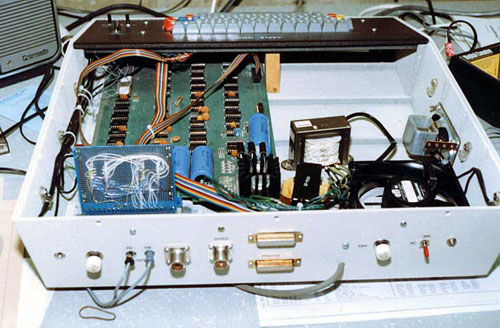
Figure 1.9 Inside Torzewski's Apple I
TO: How did you learn to program for the Apple I?
JT: Everything was self-taught; that's how it was back then. One of the main references to use for machine language programming at the time was from MOS Technology, the maker of the 6502 chip. It explained how to use each command. Larry Nelson and Richard Drennan did a lot of programming and hardware mods.
TO: What programs did you write?
JT: I did write a few games in BASIC and modified a few for the Apple I. I also did some machine language mods to add more commands to programs.
I adapted the game Gomoko in BASIC to run on the Apple I. When you played the game, you had to enter the row and column that you wanted and then the computer would draw the boxes, using dashes going across and exclamation points going down. Then it put your X or O into the box, depending if you moved first or second. You had 100 squares and had to get five in a row, diagonal, vertical or horizontal, in order to win.
TO: What hardware modifications did you perform?
JT: I added an extra 16 KB of memory to the board. This involved adding two more chips in the work area on the board and wiring and cutting tracks on the motherboard to make it work. I got that info from Professor Arthur L. Schawlow. I put in the expansion board with three extra slots and then built an EPROM board (Figure 1.10) and burned in a better Monitor ROM for the Apple I.
Others in the club added the GT-6144 graphics card and even the KIM-1 memory board.
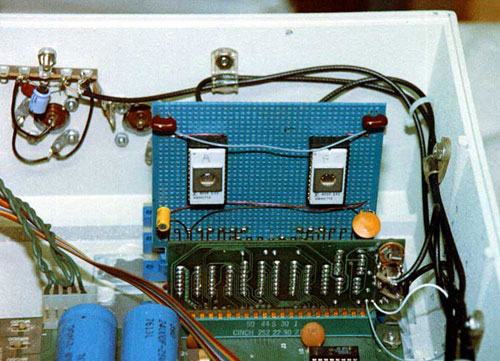
Figure 1.10 Homebrew EPROM Card
Larry Nelson
Larry Nelson has been an active participant in the Apple I Owners Club since 1977. The owner of an Apple I for many years, he has been an enthusiastic user, programmer, and hardware hacker. He is currently retired in southern Indiana and continues to use a replica of the Apple I computer for hobby purposes.
TO: When did you first learn about the Apple I? Why did you want a computer and why the Apple I?
LN: I took courses in electronics in the early Sixties and, although I didn't go to work in the industry, I did have an interest in the field. In 1977 I began to see articles in electronic magazines about the new computers for individual use. When I discovered that the Byte Shop had a store there, I drove 60 miles to Fort Wayne, Indiana. They had displays of several personal computers, and I looked at several. The Apple computer was the one that interested me the most, as it came with a great cassette interface, BASIC, and lots of memory. Soon after I discovered it, I returned to buy one for myself. This would have been in the summer of 1977. The purchase included the computer circuit board with 8 kilobytes of dynamic RAM, a cassette interface, an ASCII keyboard, an RF modulator to adapt the video output to the input of a television, and the book 101 BASIC Computer Games by David Ahl. Back home, I still had to acquire two power supply transformers, build the RF converter (it was in kit form, Figure 1.11), and wire switches and power cords to the unit. I built a case for the Apple from sheet metal, since I was operating an HVAC business at the time.
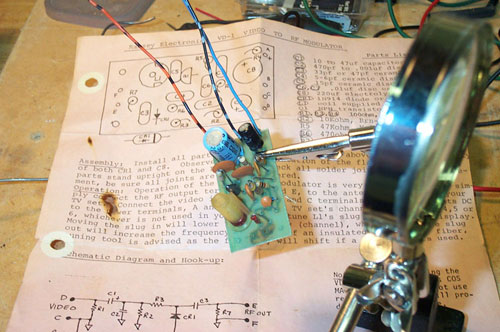
Figure 1.11 Building a VD-1 RF Modulator
TO: Could you describe the process of writing a program for the Apple I?
LN: I had no programs (other than a tape of BASIC), so the book by David Ahl was my only source of input material. My son, then a junior in high school, was interested in computer programming and went to a computer camp at nearby Anderson College for a couple of weeks while I assembled the Apple. The emphasis at the camp was on BASIC programming. The Apple was completed when he came home and he helped me learn to program in BASIC. Most of the listings I had were for "standard" BASIC, which, of course, Apple BASIC was not. The limitations of Apple BASIC included integer-only math, single-dimension arrays, and a non-standard method of string manipulation.
But with careful editing, many corrections of "syntax error" messages, and a lot of guesswork, I got a couple of games up and running, the first being "HELLO." Most games in the David Ahl book were too large for my Apple's memory.
I subscribed to Byte and Interface Age to gain more knowledge. I finally tried a little programming in Assembly language, although it required assembling a program manually, converting the listing to machine code, then typing the resulting hexadecimal into the Apple. Many hours were spent hunched over the keyboard just to see the results of a simple game. Several times, I copied hexadecimal listings from magazines into the computer, one byte at a time.
A fellow named Peter Jennings wrote a chess-playing program for the KIM-1 computer, another 6502-based microcomputer. I sent off for a listing of his program and successfully adapted it to the Apple I.
TO: What hardware modifications did you perform?
LN: I added a printer (the PR-40) that had 40 columns of width on a 4-inch paper roll. Then I replaced 4 KB of RAM with a 16 KB set of chips. Now I had an amazing 20 KB of memory, more than I would ever need! However, at a swap meet in Fort Wayne, I got another 4 KB of static RAM on a separate board, which I wired to a connector to plug into the Apple I's expansion connector. I don't think I ever had another "MEM FULL ERROR***" message after that.
TO: Tell us about the Apple I community.
LN: In response to an inquiry to the Apple Computer Company in late 1977, I found Joe Torzewski. Joe at that time had the Apple I library (about a half-dozen games, routines, and programs), and he began sending me lots of material from other Apple I owners.
Other than Joe Torzewski, I have never met another Apple I owner in person. I did happen upon a local fellow with a KIM-1 and we spent some time discussing the various things we could do with our micros. I was pleased to learn that the Apple I was far more flexible in its abilities to be programmed and the monitor output was superior to the LED display of the KIM-1.
Ray Borrill
Ray Borrill began his career in electronics after leaving the U.S. Army in 1956. Employed as a technician at Brookhaven National Labs, he constructed digital systems for nuclear research. Borrill enlisted in the U.S. Air Force in 1958 and attended courses on the computers used in the SAGE system. Honorably discharged from the Air Force in July 1959, he soon founded Applied Digital Data Systems (ADDS), which became one of the leading suppliers of IBM- and Teletype-compatible CRT terminals. He moved to Indiana in 1973 to work as a systems engineer, designing and developing computer-based systems for psychological research. In February 1976 Borrill opened The Data Domain, one of the pioneering retail computer stores. Borrill died in September 2006 at age 75.
TO: What is your background in computers?
RB: If I have any talent at all, it is the task of telling or writing "war stories" of the computer industry, which I have been directly involved with since the fall of 1958. I got into the personal computer business sort of passively in 1975, when in November I attended the famous Kansas City meeting sponsored by Byte magazine. The purpose was to develop a specification describing the operating parameters of an interface between a serial data port on a personal computer and an audio cassette player so that data could be compatible between systems. It was a lofty but naive objective because virtually every manufacturer in the industry already had a product on the market or at least on the drawing boards.
There were more than 25 people there, but I was the only one who did not represent anyone but himself. I met and became somewhat acquainted with Don Tarbell, Don Lancaster, Harry Garland of Cromemco, Hal Chamberlain of The Computer Hobbyist, Lee Felsenstein, the people from Processor Technology and IMSAI, and more. I decided there and then to open a computer store as soon as possible.
It took me almost three months, but The Data Domain started in about 750 square feet just off Court House Square, in Bloomington, Indiana, on February 12, 1976. At that time we were authorized dealers for IMSAI, Processor Technology, Cromemco, and several makers of aftermarket add-ons, as well as TV monitors, keyboards, every computer book we could find, every computer magazine on the market, and even computer-generated works of art (Figure 1.12)!
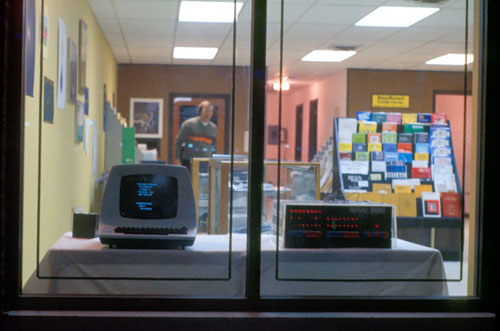
Figure 1.12 The Data Domain (Second Store Location)
At the World ALTAIR Convention in March, I met and became friends with Ted Nelson, author of Compute Lib/Dream Machine. Ted was the keynote speaker and kept the large audience in hysterics for an hour giving his somewhat risqué predictions of the future digital world. Ted was there with his friend Jim Banish, and they told me that they were opening a store in Evanston, Illinois, and thought we should establish some sort of relationship. They were interested in my experience and talent for selling computers and I could take advantage of their great financial management group. The result was that I became the vice president of the itty bitty machine company as well as the sole proprietor of The Data Domain.
I have a picture (Figure 1.13) of The Data Domain that I took in April or May of 1976. It is my firm belief that we were the first to use the term "personal computer" commercially. DEC used it internally in 1972 or '73. Apple used it in a Wall Street Journal ad in 1978 and got the credit for making it catch on, but I used it first!
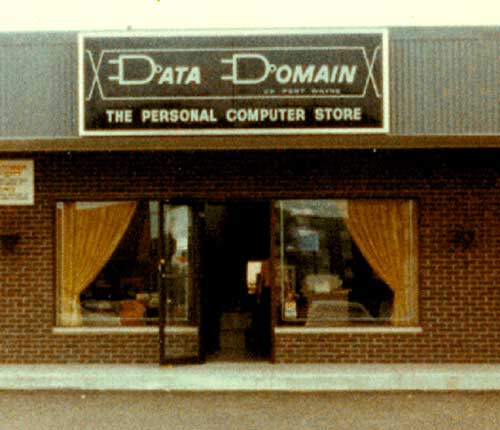
Figure 1.13 The Data Domain, Circa 1976
TO: How did you become involved with the Apple I?
RB: By June the store was going great guns and I was always on the lookout for new products to sell. One day, I got a call from a young man named Steve Jobs. He had just spoken with Jim Banish of the itty bitty machine company, who told him that I was the guy he would have to convince since I made all the purchasing decisions. He went into his spiel about what a great computer he had since there was no assembly required (a slight exaggeration since one had to wire a power supply, keyboard cable, display monitor and some other ancillary stuff, then find a way to package it all up nicely). But Jobs was a good talker and we needed some more products to sell. So, as was routine in those early days, I ordered 15 Apple I computers with the optional cassette interface card, sight unseen, on the word of a guy I had never met or heard of, and which would be delivered C.O.D. "soon."
And thus, The Data Domain the itty bitty machine company became two of the first four dealers for Apple Computer. The first dealer was The Byte Shop, and the second was Stan Viet's store in New York. The Apple I was hard to sell because of the packaging problem, and for some reason we were never supplied with the cassette version of Apple BASIC, which made some buyers very unhappy. But, eventually, all 15 were sold, except for two. One of these was a machine we gave away to the U.S. Olympic tennis team. Only a few weeks later, it was destroyed in a plane crash that killed several members of the team. The other Apple I stayed in my display case for a couple of years. When it began to gain fame for its design, I took it home and kept it. There it stayed for 25 years until I decided to auction it off in 2001.
TO: What was your impression of the Apple I? Did you do any programming for it?
RB: Of course, in my case, there was no real personal decision in choosing and purchasing the Apple I over some competitor. I listened to Jobs' sales pitch and it seemed like a good idea to be able to offer a computer that did not require any soldering skill. It was inexpensive enough to sell, and we had the opportunity to increase the value of the total sale (and thus the profit margins) by selling the things needed to make a complete system, such as a cassette recorder, power supply components, keyboard, monitor, and a case; and as a further option, we offered to assemble the whole thing. While my techs wrote some programs for the Apple I, I did not and only learned to run some demos that we wrote, and things like that. I spent more of my time teaching people how to make interfaces, etc. for all of our computers. I didn't get as closely involved with the Apple I as I did with the Apple II and S-100 bus computers.
TO: What were some common peripherals and modifications for the Apple I?
RB: Printers were popular, but in those days about the only printers available to the general public were Teletypewriters and lots of surplus units, both serial and parallel. You wouldn't believe the confusion and frustration of hooking up a simple Model 33 ASR Teletype to a serial interface when you had no idea how a Teletype works and never heard of RS-232C! One of the nice things about the Apple I was that it required no modifications to make it run and was a complete, working system once the ancillary stuff was assembled. Occasionally, someone would wish to change from the 6502 processor to the Motorola 6800, which the motherboard was designed to allow, or add a serial RS-232C interface in the "kludge" area, but these were not ordinary modifications and rarely done.
The real fact is that the Apple I's potential was never exploited by Apple. At the Atlantic City convention in August 1976, all attending dealers were shown a demonstration of the color graphics of the upcoming Apple II and that was the end of orders for the Apple I.
Liza Loop
Liza Loop is a social scientist with a focus on how individuals adapt to changing social and physical technologies. She draws her data from the everyday life that surrounds her and often sets up venues, such as the LO*OP public access computer center, so that she can be an up-close participant observer. "Every phenomenon can be interpreted as a complex system," she said. "By paying attention to the characteristics of the elements inside the system, the relationships, both real and possible, among those elements and the emergent properties of the system as a whole, we can learn how to shape our world in positive ways."
TO: When did you first learn about the Apple I?
LL: I went to a Homebrew Computer Club meeting in early 1976 and announced that I had a storefront computer center and was planning to take my machines into elementary and secondary schools. I was looking for equipment to use to demystify computing to children and the general public. Woz heard my comments and brought the Apple I to a Sonoma County Computer Club meeting for a demonstration. At that time, he gave us the computer. Before then, I knew nothing about the Apple I.
TO: Why did you choose the Apple I over other computers?
LL: Because Woz gave it to us. Actually, I found it very difficult to use. Our Apple I wouldn't stay running for a 45-minute class period and caused no end of frustration. I took it back to Woz and asked him to fix it. He made it a little better but still not very serviceable. Eventually, he provided us with an Apple II to replace it with.
TO: Did you do much programming in the classroom?
LL: I only used the machine to demonstrate simple BASIC routines and to play a few games. It was easy to take around to different schools because it was small and light. Probably 50 to 100 students ran their first 5-line BASIC programs on our Apple I. For many of them, the Apple I was the first computer they had ever seen. The workhorse of our classes, however, was a PDP-8e.
TO: What hardware modifications did you perform?
LL: Apple I number one came to LO*OP Center as a naked motherboard (Figure 1.14). One of our computer club members built it a box and a power supply. I drove two hours from our storefront in Cotati, California, to Palo Alto to buy a Cherry Pro keyboard. We used an audio tape recorder for "mass" storage.
I believe Woz added some jumper wires when he had the machine back for repair. Today we would probably call that an upgrade! Other than that it is still in original condition.
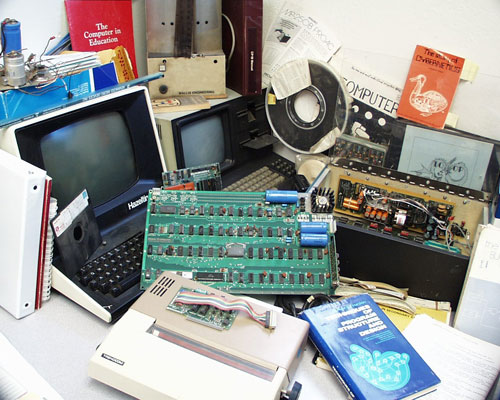
Figure 1.14 The LO*OP Center's Apple I
TO: Did you know any other Apple I owners or microcomputer hobbyists? Could you tell us about the community?
LL: In the fall of 1975 when I opened LO*OP Center (LO*OP stands for Learning Options * Open Portal), I knew next to nothing about computers. I began the Sonoma County Computer Club simultaneously so that I could create a nearby hobbyist community. Out of the Sonoma County woodwork came about 30 folks, mostly men; however, I was not the only woman who knew a lot about programming and electronics. Everyone was very excited when the MITS Altair arrived and the participants taught each other about the machines they knew. Those club members fanned out across the microcomputer industry as it grew. One worked on the original Wordstar. Another developed the first TRS-80 disk drive. Someone else wrote a stock market analysis program and retired on the bundle he made. The guy who built the Altair is still crafting acoustic guitars in the Sonoma County hills. I see some of them occasionally when I go to the Vintage Computer Festival. We're greyer, but there's a glint in our eyes that says we were involved in something really revolutionary.
For me, computers were a means to an end and not an independent interest. I needed the hobbyists to teach me and to provide hardware support. They did it happily and were very tolerant when I tuned out on the endless discussions of which capacitor applied where would increase throughput how much.
For most of 1976, LO*OP's Apple I was the only Apple in the North Bay, although there were several in Berkeley and on the Peninsula. By the time the Apple II came out, there were several single-board computers on the market that kept the hardware enthusiasts engaged. The Apple II was not a kit, so it didn't appeal as much to the Club's group of tinkerers. There was also a growing demand for a plug-and-play computer amongst science-minded highschoolers, a few teachers, and many forward-looking business types. The Apple II filled that niche in a way the Apple I never could have.
TO: What motivated you to become so involved with computers?
LL: Because I grew up among linguists and electronics pioneers, I always believed that computers would become pervasive within our society. My concern was that we would follow a path leading to all the machine-control and information-handling power of computers residing in the hands of a tiny scientific elite. When, in 1972, I discovered a Montessori primary school that was using a terminal attached to Lawrence Hall of Science as an educational "toy," I was delighted. Making sure that youngsters knew exactly how programs got into computers was the best possible vaccination against public intimidation by that elite (Figure 1.15). From then on, I put all of my available energy into finding ways to get ordinary people to take control of those mysterious machines—computers.
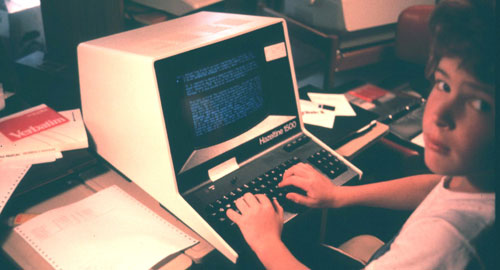
Figure 1.15 Learning at the LO*OP Center
Steve Wozniak was on a similar track. He also wanted to provide broad public access to and understanding of computers. Luckily our paths crossed at Homebrew. I'd like to think that by keeping in touch with him and sharing my woes trying to use the Apple I in educational settings, I contributed, in a small way, to the birth of the Apple II and its success in making the computer an everyday tool.
The task of harnessing the power of computing to the needs of sustainable human society is not complete. Humanity is still in danger of computing its way to extinction. Perhaps, by following the life history of those 200 Apple I's that existed for a short time, we can learn a lesson in the appropriate use of technology.
Steve Fish
Steve Fish was introduced to computers in the U.S. Navy in 1972. He worked for Burroughs Corporation as a computer systems technician in the mid Seventies in its Santa Barbara, California, minicomputer assembly plant. He attended Brooks Institute in Santa Barbara and graduated with a degree in photography. He became immediately involved in the microcomputer revolution and founded Peripheral Visions, which specialized in photographic and audiovisual software and hardware until the early 1990's. Fish now works as a freelance underwater photographer, filmmaker, and Web designer.
TO: Did you have any background in computers previous to the Apple I?
SF: In the mid-1970's, I spent a lot of time prowling the few computer stores that existed in those days, looking for a way to get back into computers. In the Navy, I had worked a little bit with Super Nova Micro computers around 1972-73. After the Navy, I used that experience and worked for a few months as a computer technician for Burroughs before returning to college. Though I had repaired quite a lot of computer processors and peripherals, I hadn't ever really done any programming. Running maintenance routines wasn't all that much fun. I took a "programming" class, but it consisted mostly of punching cards and sorting them into stacks. Not very satisfying.
TO: When did you first learn of the Apple I?
SF: In 1976, when the Apple I was first introduced, a small computer store called Computer Playground had just opened in Orange County, California, near where I was working. In addition to selling the Apple I and the limited other hardware items that were available at that time, they had a number of Apple I systems installed as "workstations" that you could rent by the hour to play games or write your own programs. I started frequenting the establishment to play games (which was much more fun than sorting a stack of punch cards) and took a BASIC programming course taught by Dr. Will Otaguro, one of the owners. While I don't remember the first program I wrote, I definitely remember the feeling of instant gratification when I ran it without having to run a stack of cards through a Teletype and wait for a line printer to churn out a ream of paper. These computers were cool! They were self-contained, and when you hit the Return key, execution was immediate.
The Apple I workstations were built into a false wall with a keyboard shelf and a monitor behind a window. Everything else was in the back; you never actually saw the hardware. You could play Startrek, Life, Lunar Lander, or several other games. When you wanted to play a different game, or tinker in BASIC, a staff member (usually Will) would go into the back room where the motherboards and monitors were and load the program for you. The Apple I systems that they had for sale were a bit fancier. They had custom-made walnut cases with built-in keyboards. They looked a little like wooden versions of the (future) Apple II.
The store gained quite a following. Any evening you would find several users sitting at their keyboards, either banging away at a program or playing one of the games. Not many were programming anything in machine language at that point; it was pretty much all in BASIC because there wasn't an assembler for the Apple I in the early days. Heck, even Woz was hand-coding his machine language at that point; BASIC was written on paper!
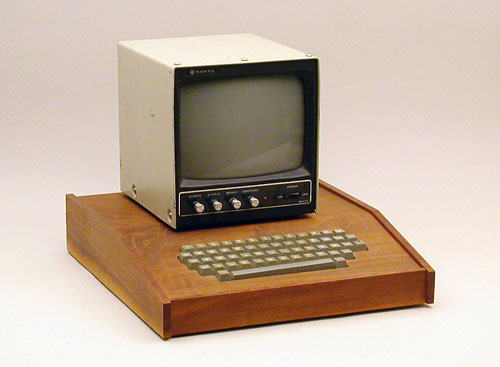
Figure 1.16 Fish's Apple I
TO: When did you decide to buy an Apple I?
SF: I didn't buy an Apple I immediately. I rented a lot of time on them, though. When the Apple II came out, I decided to take the plunge and bought a 4 KB Apple II motherboard. Yes, initially, you could just buy an Apple II board and add your own keyboard and power supply just like the Apple I. That stopped after the Apple II was on the market a few months, but I got one out of the first production run (serial number 468) and still have it. When the Apple II was introduced, the Apple I market dried up pretty fast. Everyone (myself included) was hot for the II. Computer Playground merged with another Los Angeles-area computer store called Computer Components and moved into much larger quarters. In the move, the idea of workstations that you could rent time on sort of died off (until the revival of the cybercafé 20 years later). All of the workstation Apple I's and a couple of the nice walnut-cased units were sold off at clearance prices. I bought one of the nice Apple I's in the walnut case in late 1977, mostly out of nostalgia (Figures 1.16 and 1.17). It was the machine that I learned to program on, and they were dirt cheap by that time. I believe that the bare-board systems were donated to an Explorer Post in the area for Geek Scouts to play with.
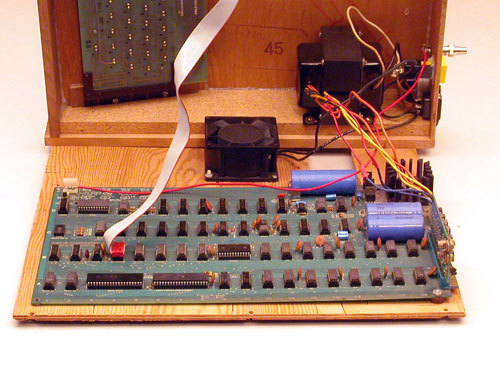
Figure 1.17 Inside Fish's Apple I
TO: How did you use your Apple I?
SF: I'm not sure if I ever even powered up my Apple I after I bought it. I think I probably just put it in the closet, figuring I'd get it out and play with it someday. That day didn't happen until about 28 years later when I found the Apple I Owners Club on Applefritter by chance, and was inspired to get it out and dust it off. I had a few minor problems getting it running, but mostly it was just a couple wires that had broken from being moved around and a keyboard problem. At any rate, it's now alive and well, and in pretty much the same condition it was when it was brand new. No hacks or mods on the motherboard. It's as close to being mint as a 28-year-old computer can be. It was never owned by anyone else, or even used until 2005. I have the Sanyo 9" black-and-white monitor that was originally used on my Apple II, but it is of the same vintage as the Apple I. Also, a Panasonic cassette recorder was originally used with my Apple II, but is the same model that was being used with the Apple I at that time for loading programs. The cassette interface on the Apple I was always a little bit on the fussy side, but once you got the input and output levels set correctly, it hummed along quite nicely. It's only about 1500 baud, but in those days, that was quite fast. Mine still has the original 8 KB RAM configuration. In 1977, 16 KB RAM chips cost about $500 for a set of eight. Though I have a box full of 16 KB chips now, I'm choosing to leave the Apple I in its original configuration.
I've been an Apple user continuously since 1976. I suspect that there aren't a lot of us left who have never, ever gone over to "the Dark Side." Heck, even Steve Jobs was a NeXT user for a few years. When I compare the capabilities of my Apple I of 1977 with my current Mac PowerBook, it's almost like a science fiction story come true. I feel very privileged to have been involved with personal computing literally from the very start. I wonder what the next 30 years will bring; I bet it will be wickedly cool.
Allen Baum
Allen Baum is a principal engineer at Intel working on enterprise processor architectures. Previously, he worked at Digital Equipment Corporation and Compaq Computer on the StrongARM (SA1500) and Alpha EV7 and EV8 processor designs. Prior to DEC he worked on the Newton, Apple II, and proprietary processors at Apple, and was a designer of the PA-RISC architecture and HP 45 calculator at Hewlett-Packard. He received his BSEE and MSEE from Massachusetts Institute of Technology in 1974. He is named on over 17 patents in the area of processor architectures and is chair of the IEEE Technical Committee on Microprocessors and Microcomputers, which oversees the Hot Chips conference.
TO: Could you tell us about the Homebrew Computer Club and your involvement with it?
AB: My involvement was as a "charter" (I guess) member. I saw a flyer for the first meeting (probably at the People's Computer Center) and thought that Steve [Wozniak] would be interested and dragged him along.
The Homebrew Computer Club was arguably the earliest meeting place for hobbyists who had, or dreamed of having, their own personal computer. It started in Gordon French's garage, where he demonstrated his Altair to us. Most of the early personal computer companies started there.
The club was later "conducted" by ringmaster Lee Felsenstein (himself greatly responsible for many early personal computer successes) and grew to fill the auditorium of Stanford's Linear Accelerator Center. It served as a forum for product (and project) introductions and demos, software and information exchanges, asking and getting advice on problems (both in design and use of products), and just being able to mingle with other like-minded people.
TO: What did you use your Apple I for? What programs did you write?
AB: I was mostly writing development utilities for it. Steve was hand-assembling his code and typing it in hex. He could do that in his head, and he was an extremely fast and accurate typist. I wasn't; so, even after hand-assembling, trying to figure out if what I typed in was what I had intended was tough. So, the first thing I wrote was the disassembler, which would allow me to see whether I typed the right thing in.
The next thing was a mini-assembler, which used the disassembler as a subroutine (basically, the assembler guessed all possible values, ran it through the disassembler, and stopped when it matched). Steve and I worked over those and got the sizes down to under 256 bytes each—I credit him for saving most of the bytes.
After that, I started working on a debugger and a Fortran compiler, but got bogged down with engineers' disease (I kept designing it trying to get it perfect, but never actually finished).
TO: Any stories to share?
AB: I remember Steve sitting in the lobby of Homebrew with his hand-wired Apple I (in addition to being an incredibly fast, accurate typist, he's the best technician I know—his wiring and soldering were unbelievably neat and careful) typing in his BASIC interpreter in hex—all 4 KB, trying to get it done before the break. He'd type a bunch and then would have to check it all, character by character, to make sure he hadn't blown it (he didn't, very often).
I think that's when I decided to write the disassembler and when he decided he'd better get a cassette interface working.
Apple contracted with one of Woz's fellow HP employees to design the cassette interface. It was a board full of opamps and analog parts. I think Woz was pretty disgusted—it was way overkill, so he chucked it and redesigned it to work with a few really simple parts, cutting down to a tenth its original size and cost. Steve was always really focused on getting the absolute simplest, lowest-cost design.
Summary
The Apple I is so primitive compared to computers today that it's difficult to imagine a time when users entered programs in machine code and connecting a printer required use of a soldering iron. Nothing about the Apple I was a mystery to its users. They knew how determine the function of every wire on the motherboard and every byte of code in their programs. As you learn to program and build your replica of the Apple I, you'll have the opportunity to learn all the secrets of its inner workings.
| ← Previous | Contents | Next → |
